The Eternal Life
This is the basic shape of eternal life, used in both Japanese and Chinese official rules to describe the situation. To reply to  attack, white cannot simply capture the stone at *b3*. Otherwise black would play
attack, white cannot simply capture the stone at *b3*. Otherwise black would play  to form a Bulky Five shape to kill.
to form a Bulky Five shape to kill.  is a brilliant move. After
is a brilliant move. After  capture and
capture and  recapture, the board returns to its original position.
recapture, the board returns to its original position.
Tsumego
Such patterns are quite well-known because the traditional tsumego books Xuanxuan Qijing(玄玄棋经), Gokyo Shumyo(棋经众妙) and Igo Hatsuyoron(围棋发阳论) all contain problems resulting in eternal life. Following is the problem No. 124 of Igo Hatsuyoron:
 is a sente move.
is a sente move.  creates the basic shape for eternal life. Actually the situation outside the corner is more interesting.
creates the basic shape for eternal life. Actually the situation outside the corner is more interesting.
If  is ignored, then
is ignored, then  is a tesuji. If white plays *w4*, black can easily connect from the side with tesuji *b7*.
is a tesuji. If white plays *w4*, black can easily connect from the side with tesuji *b7*.
If white plays  instead, the situation becomes slightly more complex.
instead, the situation becomes slightly more complex.  appears to be a good move - to avoid a ladder at the same time prevent white from running out. However, black's plan is flawed because white can play
appears to be a good move - to avoid a ladder at the same time prevent white from running out. However, black's plan is flawed because white can play  directly to win the capturing race in the corner.
directly to win the capturing race in the corner.
To rectify the situation, black  and following is a better sequence, forcing white to create the Bulky Five in the corner, extending liberties first, before returning to
and following is a better sequence, forcing white to create the Bulky Five in the corner, extending liberties first, before returning to  to win the race on the side.
to win the race on the side.
 is another possibility. But
is another possibility. But  can run out and it is impossible for white to enclose the group. Again black can use the Bulky Five in the corner to gain more liberties should a capturing race occurs.
can run out and it is impossible for white to enclose the group. Again black can use the Bulky Five in the corner to gain more liberties should a capturing race occurs.
Professional games
The tsumego problems contain mostly man-made shapes that cannot be easily materialised. For this reason, Eternal Life is extremely rare in professional games. To my knowledge there are only three examples:
Example 1
The first one, presented by the knowledgeable GoGoD team on the lifein19x19 forum, is strictly speaking not a professional game. The game was between Kono Mitsuki and Kurotaki Masanori, both Insei at the time of the play. They both became professional players of Nihon Kiin later. Kono Mitsuki is now a 8-dan professional and Kurotaki Masanori a 7-dan.
This rather peaceful game was heading to small yose stage when a ko fight suddenly erupted. Out of nowhere, white miraculously created the Eternal Life shape while playing ko threats in a black corner. This shape is the exactly the basic Eternal Life shape.
Example 2
Follow this link to view the game: http://www.go4go.net/go/games/sgfview/31860
The second game is significantly more interesting for several reasons. First the non-technical reasons:
- It was between two famous players: Rin Kaiho vs. Komatsu Hideki.
- It was in a major tournament: in the League stage of the 49th Japanese Honinbo tournament.
The game was very peaceful and even a bit boring. When white played W246, the game was extremely close and was to be decided by the outcome of the last half-point ko. White played very accurately - W248, W250 and W252 were all to remove black's ko threats before actually starting the ko at W254. Both sides had many ko threats so the ko lasted all the way to move B317.
At this moment black must connect the half-point ko at  - he has one more ko threat (*b4*) but so does white (*w7*), so black would lose the game by 0.5 points if not playing *b2*. They started fighting a different ko. Amazingly both sides can use local threats (*w6* and *b10*) that results in the board position repeated every 6 moves. This is by definition an Eternal Life.
- he has one more ko threat (*b4*) but so does white (*w7*), so black would lose the game by 0.5 points if not playing *b2*. They started fighting a different ko. Amazingly both sides can use local threats (*w6* and *b10*) that results in the board position repeated every 6 moves. This is by definition an Eternal Life.
Instead of sticking to the eternal life, black has the option to connect at *b10*, still winning the ko fight. But black would have to fill both  and *b14*. In Japanese rule that would result in black losing one point so he would still lose the game by 0.5 point.
and *b14*. In Japanese rule that would result in black losing one point so he would still lose the game by 0.5 point.
This eternal life is technically much more interesting because:
- There is a ko involved - so this is sometimes called an Eternal Ko.
- Both sides need to put own stones under atari (in the standard eternal life, only one side needs to do so).
- The 0.5 point difference is a prerequisite, otherwise black doesn't have to play
 or
or  in Fig. 1.
in Fig. 1.
Because this was a league game, both players were awarded half a point towards their league scores, a rather happy ending. In other situations, a replay might be ordered.
Example 3
Follow this link to view the game: http://www.go4go.net/go/games/sgfview/21834
The third example is a game between Uchida Shuhei 3-dan and O Meien 9-dan. While the previous eternal life example happened in yose stage, this one was during mid-game. And it was once again an eternal ko!
The players had been fighting a messy approach ko at upper-left corner. Black just created a directly ko at *b1*.  is black's local threat. In response,
is black's local threat. In response,  is white's local threat. Because this ko is so valuable and neither of them could afford to lose it, they had to settle in an enternal ko.
is white's local threat. Because this ko is so valuable and neither of them could afford to lose it, they had to settle in an enternal ko.

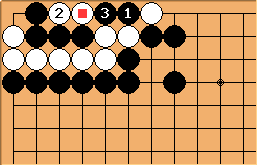
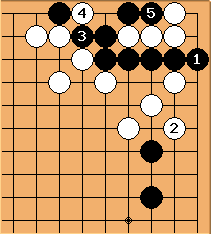
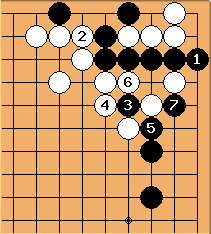
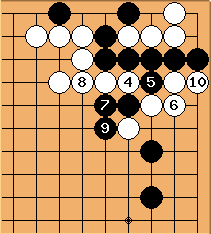
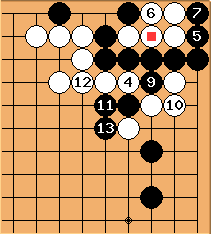
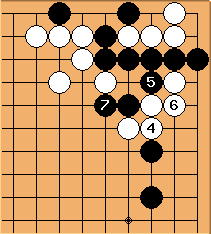
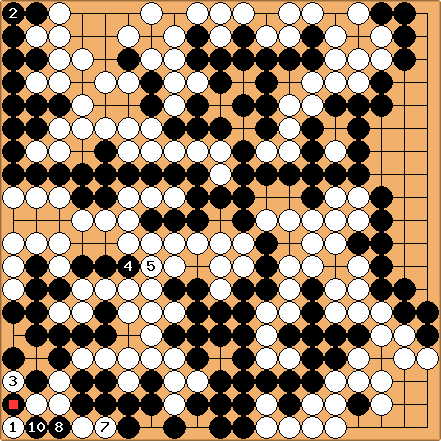
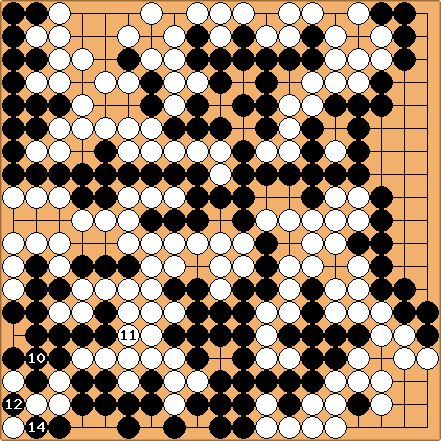
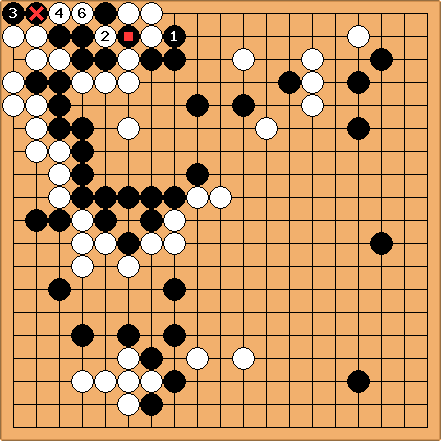
Comments
problem
anyways after w caps blacks 2 stones and b plays t16 to cap and w plays at t14 why doesnt b just cap the 1 stone and there you go b capped the 4 stones with 2 eyes
answer
I think you are talking about the game in Example 1. After white T14, black cannot just capture one stone. Otherwise white would play T17 to form a bulky five big-eye dead shape.
More reference
This is a blog article covering one of the game I discussed:
http://my.opera.com/phuongledanh/blog/chosei-enternal-life-chapter-1